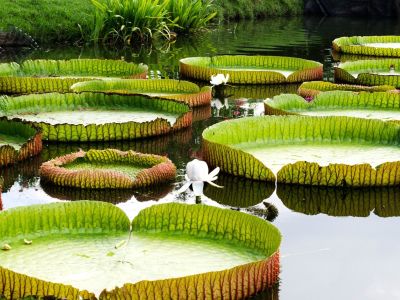The leaves “float” on the surface of the water, supported by spongy veins. Their size allows the plant to take in the maximum sunshine possible. The underside of each leaf has spines, thought to be a way of preventing fish from nibbling on them. Leaves are anchored by submerged stalks up to 26 feet (7.9 m) long that embed themselves in the lake or river bottom.
Victoria Water Lily
Given that the native range of this large lily is in South America, from Bolivia in the south to Guyana in the north, one might wonder why it is called the Victoria water lily. The name was chosen in 1837 as a way to honor Queen Victoria of England who had ascended to the throne that year. The entire Victorian era was named after the Queen, and it was during this era that exotic plants, including the Victoria water lily became popular in cultivation.
Giant Water Lily Facts
A giant water lily in bloom is exotic and dramatic. Like the leaves, the flowers are oversize, dinner plate-size blooms that open at night and last a few days only. The first day of a bloom, the white lily opens in the evening as a female flower, offering a sweet fragrance of pineapple. The blossom creates its own warmth, thought to be a giant water lily adaptation that lures scarab beetles to visit the flower. The second evening, the blossom closes, trapping the beetles inside. At this time the flower changes from female to male, the petals turn pink and begin to produce pollen. That evening, the blossom opens again, releasing the beetles. They are covered in the flower’s pollen and fly away to pollinate female flowers.
